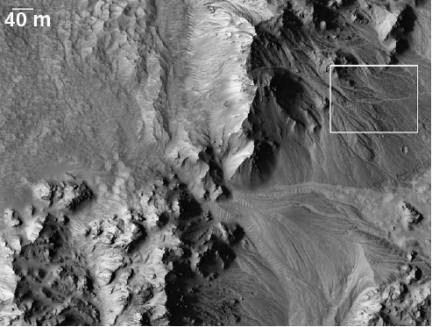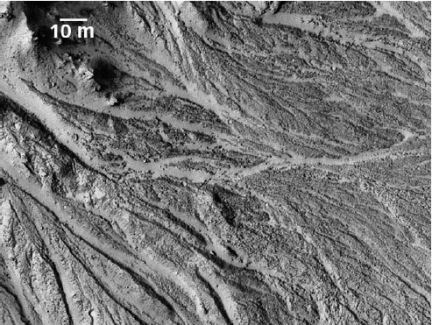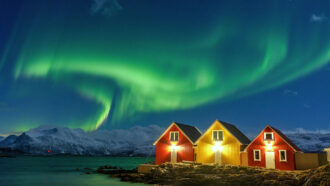Wet or Not?
New evidence lowers the chances of finding water on Mars.
By Emily Sohn
Does Mars have liquid water on it or not? That question has been a hot topic for a long time, with evidence accumulating on both sides.
The newest analysis has come out mostly negative. Based on the sharpest images ever taken of the Red Planet from an orbiting satellite, it appears that water did once flow on Mars. Today, however, chances of finding running water there look slim.
 |
|
The photo above shows Mars’ Mojave crater, which is 60 kilometers (37 miles) wide. The photo below is a close-up of fan-shaped streaks and channels in the crater. These features suggest that water once flowed through the area after a meteoroid struck and and melted the icy surface.
|
| NASA |
 |
|
|
| NASA |
The latest images come from a NASA spacecraft called Mars Reconnaissance Orbiter (MRO). The orbiter reached Mars last year. It is now collecting more data every week than many missions collect during their entire lives.
MRO’s cameras and other instruments capture high-resolution images that show tiny details, even from outer space. In the new images, it is possible to see features that measure just 50 centimeters (20 inches) across. That’s 10 times as detailed as previous satellite pictures.
MRO recently focused its instruments on two steep gullies that scientists had looked at 15 months ago. At that time, researchers saw deposits that formed bright streaks on the gullies. They suspected that a recent flow of salty water evaporated, leaving these streaks of minerals behind.
But the newest data tell a different story. Scientists from the University of Arizona in Tucson found no minerals in the deposits that would suggest the presence of water.
The scientists also looked for changes in the shapes of the streaks. Any changes would indicate that an underground supply of water had rushed to the cold surface in recent months or years. The researchers saw no such changes.
The scientists now propose that landslides of dry, sandy material, rather than liquid water, could have formed the bright deposits in the steep gullies. The team published one of several new reports on the latest MRO images.
In another new report, scientists from the U.S. Geological Survey in Flagstaff, Ariz., and their colleagues looked again at a system of channels called Athabasca Valles. The channels are about 300 kilometers (186 miles) long.
In previous, less detailed images taken by older spacecraft, the channels looked like frozen seas. It is still possible that water carved the system, but the new images suggest that the channels of Athabasca Valles are more likely the remains of a “once-swollen river of lava,” the Arizona researchers say.
In the past, scientists have pointed to evidence of liquid water at nearly all times and places on Mars, says Alfred McEwen of the University of Arizona in Tucson. The new data, he says, show that interpreting features on planets “can completely change with better observations.”
That doesn’t mean that Mars is and always has been waterfree.
The Tucson scientists saw clear signs of watery flows in gullies that are not steep enough to form landslides. These flows could have occurred several million years ago, they say. Back then, the climate on Mars was probably warmer than it is today.
The MRO camera also revealed fan-shaped deposits and branching channels next to several large craters. These features could have formed when meteoroids slammed into an icy crust, creating brief flows of water that shaped the land.
All together, the evidence suggests that Mars has experienced periods of warm, wet weather in certain places. That kind of weather, however, probably never encompassed the entire planet at the same time.
The presence of water would be an important sign that life is or once was possible on Mars. So far, there have been no signs of Martian life-forms.—Emily Sohn
Going Deeper:
Cowen, Ron. 2007. Muddying the water? Orbiter drains confidence from fluid story of Mars. Science News 172(Sept. 22):181. Available at http://www.sciencenews.org/articles/20070922/fob5.asp .







